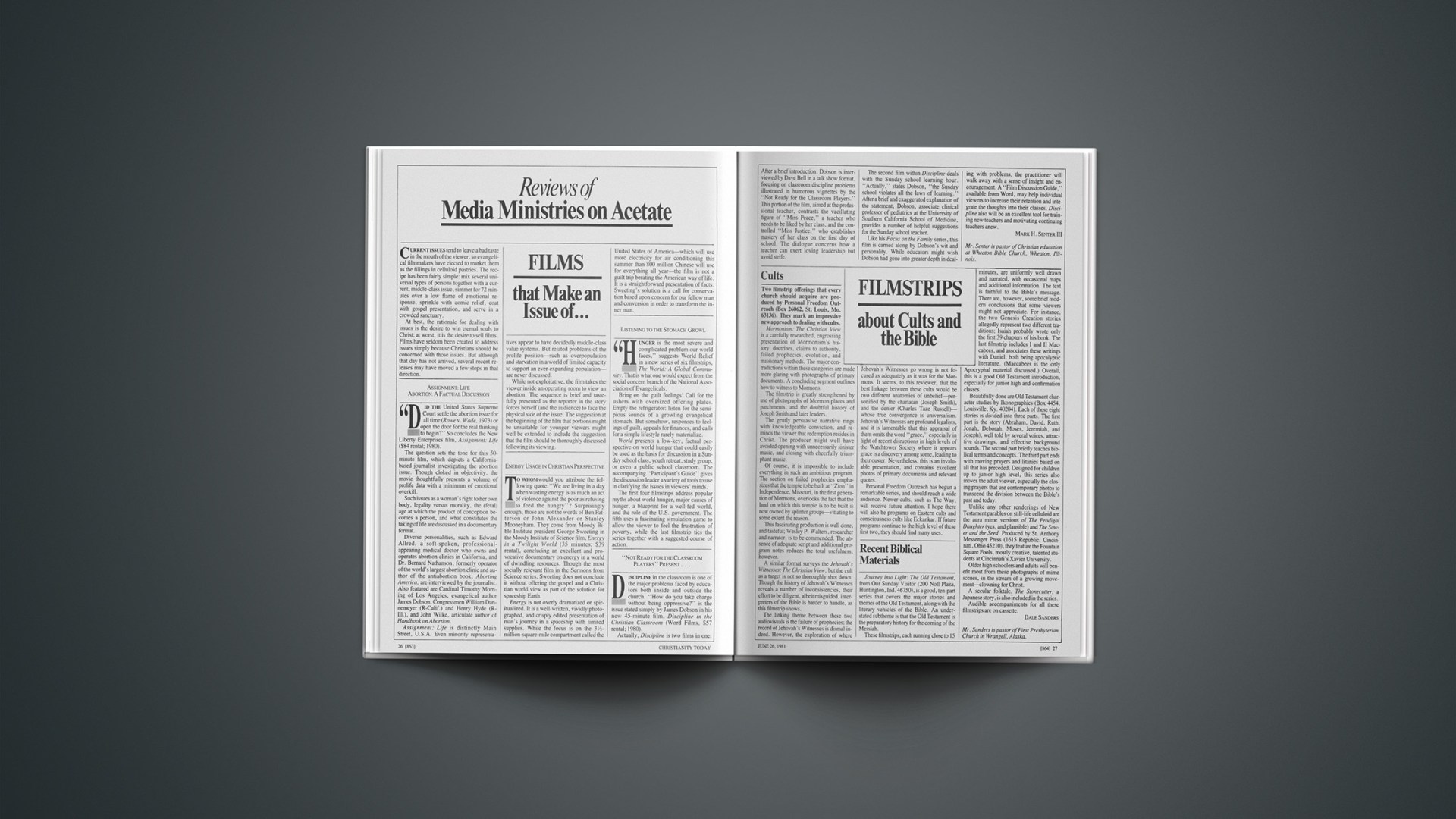Cults
Two filmstrip offerings that every church should acquire are produced by Personal Freedom Outreach (Box 26062, St. Louis, Mo. 63136). They mark an impressive new approach to dealing with cults.
Mormonism: The Christian View is a carefully researched, engrossing presentation of Mormonism’s history, doctrines, claims to authority, failed prophecies, evolution, and missionary methods. The major contradictions within these categories are made more glaring with photographs of primary documents. A concluding segment outlines how to witness to Mormons.
The filmstrip is greatly strengthened by use of photographs of Mormon places and parchments, and the doubtful history of Joseph Smith and later leaders.
The gently persuasive narrative rings with knowledgeable conviction, and reminds the viewer that redemption resides in Christ. The producer might well have avoided opening with unnecessarily sinister music, and closing with cheerfully triumphant music.
Of course, it is impossible to include everything in such an ambitious program. The section on failed prophecies emphasizes that the temple to be built at “Zion” in Independence, Missouri, in the first generation of Mormons, overlooks the fact that the land on which this temple is to be built is now owned by splinter groups—vitiating to some extent the reason.
This fascinating production is well done, and tasteful; Wesley P. Walters, researcher and narrator, is to be commended. The absence of adequate script and additional program notes reduces the total usefulness, however.
A similar format surveys the Jehovah’s Witnesses: The Christian View, but the cult as a target is not so thoroughly shot down. Though the history of Jehovah’s Witnesses reveals a number of inconsistencies, their effort to be diligent, albeit misguided, interpreters of the Bible is harder to handle, as this filmstrip shows.
The linking theme between these two audiovisuals is the failure of prophecies; the record of Jehovah’s Witnesses is dismal indeed. However, the exploration of where Jehovah’s Witnesses go wrong is not focused as adequately as it was for the Mormons. It seems, to this reviewer, that the best linkage between these cults would be two different anatomies of unbelief—personified by the charlatan (Joseph Smith), and the denier (Charles Taze Russell)—whose true convergence is universalism. Jehovah’s Witnesses are profound legalists, and it is lamentable that this appraisal of them omits the word “grace,” especially in light of recent disruptions in high levels of the Watchtower Society where it appears grace is a discovery among some, leading to their ouster. Nevertheless, this is an invaluable presentation, and contains excellent photos of primary documents and relevant quotes.
Personal Freedom Outreach has begun a remarkable series, and should reach a wide audience. Newer cults, such as The Way, will receive future attention. I hope there will also be programs on Eastern cults and consciousness cults like Eckankar. If future programs continue to the high level of these first two, they should find many uses.
Recent Biblical Materials
Journey into Light: The Old Testament, from Our Sunday Visitor (200 Noll Plaza, Huntington, Ind. 46750), is a good, ten-part series that covers the major stories and themes of the Old Testament, along with the literary vehicles of the Bible. An understated subtheme is that the Old Testament is the preparatory history for the coming of the Messiah.
These filmstrips, each running close to 15 minutes, are uniformly well drawn and narrated, with occasional maps and additional information. The text is faithful to the Bible’s message. There are, however, some brief modern conclusions that some viewers might not appreciate. For instance, the two Genesis Creation stories allegedly represent two different traditions; Isaiah probably wrote only the first 39 chapters of his book. The last filmstrip includes I and II Maccabees, and associates these writings with Daniel, both being apocalyptic literature. (Maccabees is the only Apocryphal material discussed.) Overall, this is a good Old Testament introduction, especially for junior high and confirmation classes.
Beautifully done are Old Testament character studies by Ikonographics (Box 4454, Louisville, Ky. 40204). Each of these eight stories is divided into three parts. The first part is the story (Abraham, David, Ruth, Jonah, Deborah, Moses, Jeremiah, and Joseph), well told by several voices, attractive drawings, and effective background sounds. The second part briefly teaches biblical terms and concepts. The third part ends with moving prayers and litanies based on all that has preceded. Designed for children up to junior high level, this series also moves the adult viewer, especially the closing prayers that use contemporary photos to transcend the division between the Bible’s past and today.
Unlike any other renderings of New Testament parables on still-life celluloid are the aura mime versions of The Prodigal Daughter (yes, and plausible) and The Sower and the Seed. Produced by St. Anthony Messenger Press (1615 Republic, Cincinnati, Ohio 45210), they feature the Fountain Square Fools, mostly creative, talented students at Cincinnati’s Xavier University.
Older high schoolers and adults will benefit most from these photographs of mime scenes, in the stream of a growing movement—clowning for Christ.
A secular folktale, The Stonecutter, a Japanese story, is also included in the series.
Audible accompaniments for all these filmstrips are on cassette.
DALE SANDERS1Mr. Sanders is pastor of First Presbyterian Church in Wrangell, Alaska.










